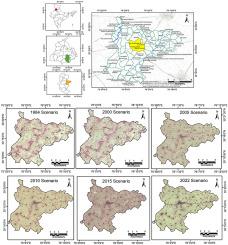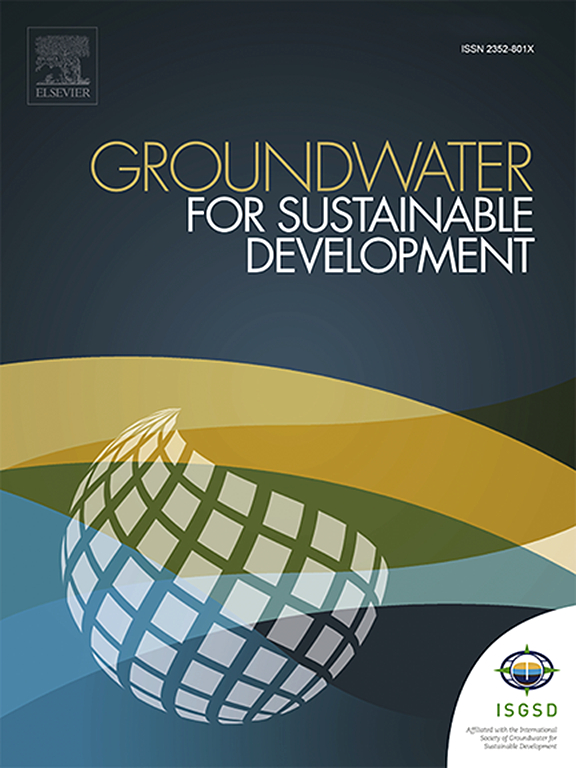Hydrogeophysical mapping of paleochannels for water security in Bhawanigarh Block, District Sangrur, Punjab, India
IF 4.9
Q2 ENGINEERING, ENVIRONMENTAL
引用次数: 0
Abstract
Paleochannels, ancient buried riverbeds, offer significant potential for groundwater management and contribute to achieving the Sustainable Development Goals (SDGs), particularly those focused on clean water (SDG 6) and sustainable ecosystems (SDG 15). These channels, formed when rivers change course due to natural processes or human activities, become filled with loose, permeable sediments like sand and gravel, making them natural reservoirs capable of storing large volumes of groundwater. This characteristic makes paleochannels invaluable for enhancing water security in arid and semi-arid regions.
The present study, conducted in the Bhawanigarh block of Sangrur District, Punjab, focuses on mapping paleochannels for Managed Aquifer Recharge (MAR) using Electrical Resistivity Survey techniques. A total of 37 Vertical Electrical Soundings (VES) were performed with a Computerized Resistivity Meter, and the findings were validated using well-logging, exploration data, historical aerial photographs, and satellite imagery. Identifying and mapping these paleochannels enable targeted groundwater recharge efforts, enhancing the sustainable management of water resources.
By strategically utilizing paleochannels for artificial recharge, excess surface water can be directed into these hidden reservoirs, effectively replenishing groundwater supplies. This approach supports agricultural and drinking water needs and strengthens resilience against climate change impacts, aligning with SDG 13 (Climate Action). Moreover, the careful management of these ancient channels promotes the sustainable use of natural resources, contributing to the overall goals of environmental sustainability and water security outlined in the SDGs.

印度旁遮普省桑格鲁尔地区巴瓦尼加尔区古河道水文地质物理测绘,促进水安全
古河道是古代埋藏的河床,为地下水管理提供了巨大潜力,有助于实现可持续发展目标(SDGs),尤其是以清洁水(SDGs 6)和可持续生态系统(SDGs 15)为重点的目标。这些河道是由于自然过程或人类活动导致河流改道而形成的,河道中充满了沙子和砾石等疏松、渗透性强的沉积物,使其成为能够储存大量地下水的天然水库。本研究在旁遮普省桑格鲁尔地区的巴瓦尼加尔区进行,重点是利用电阻率测量技术绘制古河道图,用于管理含水层补给(MAR)。使用计算机化电阻率测量仪共进行了 37 次垂直电测深 (VES),并使用测井记录、勘探数据、历史航拍照片和卫星图像对结果进行了验证。通过战略性地利用古河道进行人工补给,可以将多余的地表水引入这些隐蔽的水库,从而有效补充地下水供应。这种方法既能满足农业和饮用水需求,又能增强抵御气候变化影响的能力,符合可持续发展目标 13(气候行动)。此外,对这些古老渠道的精心管理促进了自然资源的可持续利用,有助于实现可持续发展目标中提出的环境可持续性和水安全的总体目标。
本文章由计算机程序翻译,如有差异,请以英文原文为准。
求助全文
约1分钟内获得全文
求助全文
来源期刊

Groundwater for Sustainable Development
Social Sciences-Geography, Planning and Development
CiteScore
11.50
自引率
10.20%
发文量
152
期刊介绍:
Groundwater for Sustainable Development is directed to different stakeholders and professionals, including government and non-governmental organizations, international funding agencies, universities, public water institutions, public health and other public/private sector professionals, and other relevant institutions. It is aimed at professionals, academics and students in the fields of disciplines such as: groundwater and its connection to surface hydrology and environment, soil sciences, engineering, ecology, microbiology, atmospheric sciences, analytical chemistry, hydro-engineering, water technology, environmental ethics, economics, public health, policy, as well as social sciences, legal disciplines, or any other area connected with water issues. The objectives of this journal are to facilitate: • The improvement of effective and sustainable management of water resources across the globe. • The improvement of human access to groundwater resources in adequate quantity and good quality. • The meeting of the increasing demand for drinking and irrigation water needed for food security to contribute to a social and economically sound human development. • The creation of a global inter- and multidisciplinary platform and forum to improve our understanding of groundwater resources and to advocate their effective and sustainable management and protection against contamination. • Interdisciplinary information exchange and to stimulate scientific research in the fields of groundwater related sciences and social and health sciences required to achieve the United Nations Millennium Development Goals for sustainable development.
 求助内容:
求助内容: 应助结果提醒方式:
应助结果提醒方式:


